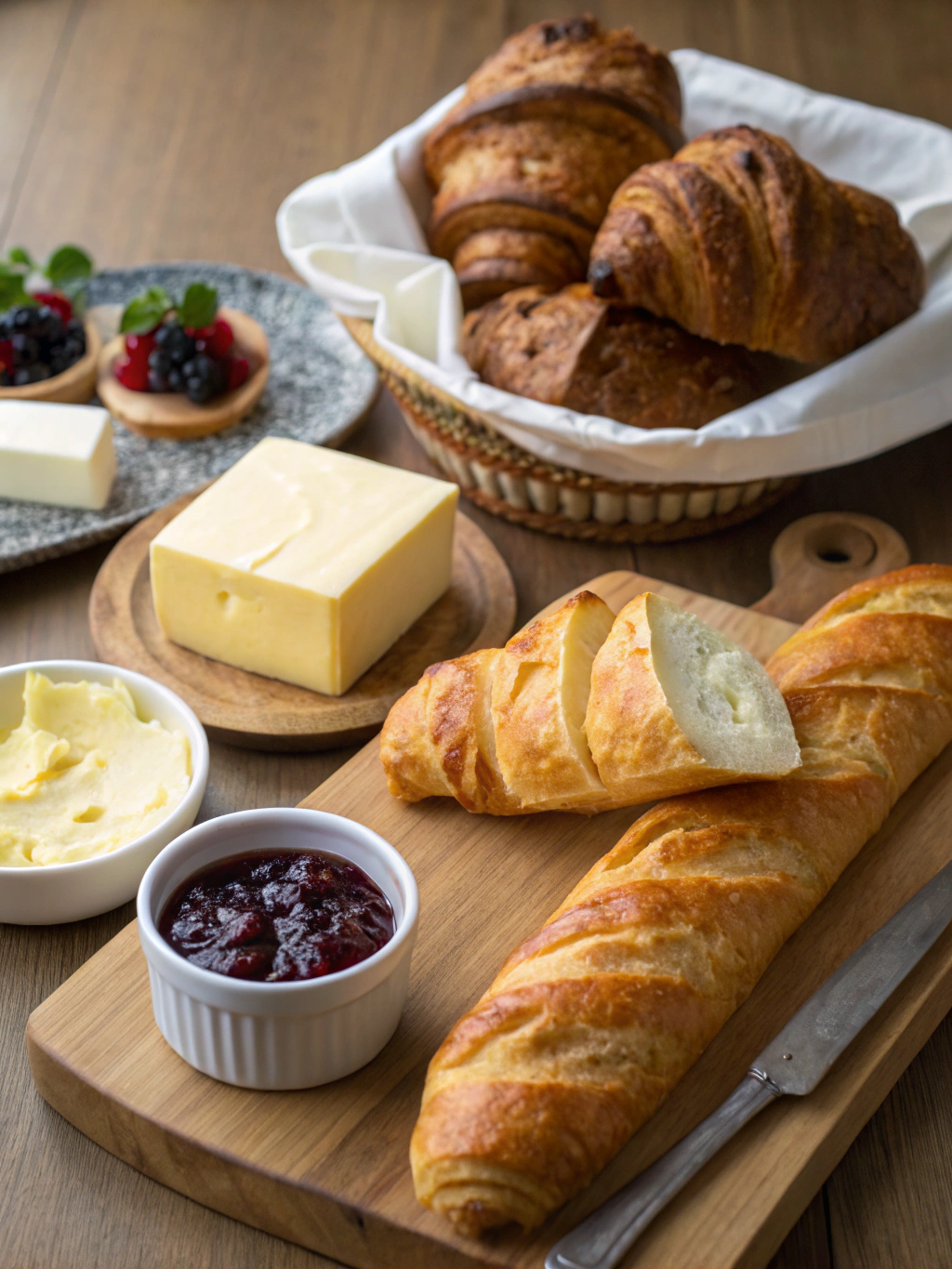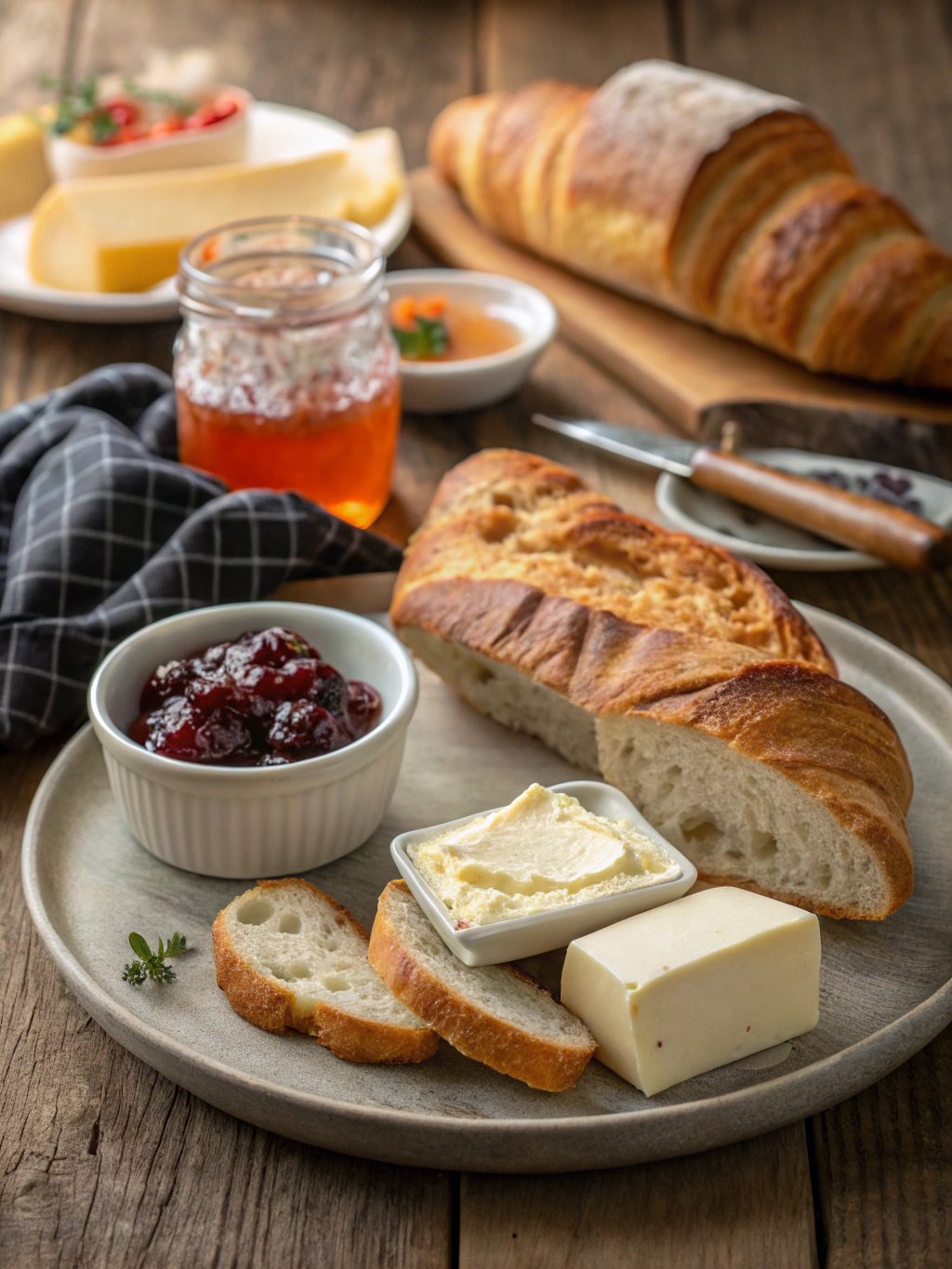Traditional French Breakfast Foods: How to Make Them at Home
Love French pastries and buttery toast? Learn how to prepare traditional French breakfast foods in your own kitchen. Start your day the French way!
Did you know that 78% of French people consider breakfast (le petit déjeuner) the most important meal of their day, yet they spend an average of just 13 minutes enjoying it? This fascinating contradiction reveals much about the French approach to morning dining—simple yet deliberate, efficient yet indulgent.
While Americans might grab coffee on-the-go, the French prioritize quality over quantity, focusing on a few Traditional items done exceptionally well. Making traditional French breakfast foods at home isn’t just about following recipes—it’s about embracing a cultural ritual that balances restraint with pleasure.
From the perfect crusty baguette with butter and jam to delicate pain au chocolat, these morning classics are surprisingly accessible to prepare in your own kitchen, bringing a touch of Parisian charm to your breakfast table.
Table of Contents
Traditional French Breakfast Foods: How to Make Them at Home
Ingredients List

For a complete French breakfast experience, you’ll need these essential ingredients:
For Croissants (4 servings):
- 2 cups all-purpose flour (substitute: bread flour for extra chewiness)
- 1 teaspoon salt
- 2 tablespoons sugar (substitute: honey for a different dimensional sweetness)
- 1 tablespoon active dry yeast
- 1¼ cups unsalted European-style butter, cold but pliable (substitute: regular butter, though the result won’t be as flaky)
- 1 egg (for egg wash)
For Pain au Chocolat (4 servings):
- Croissant dough (as above)
- 4 ounces high-quality dark chocolate batons or chunks (60-70% cocoa content)
For French Toast (Pain Perdu – 2 servings):
- 4 thick slices day-old baguette or brioche (the slight staleness actually improves absorption)
- 2 large eggs
- ⅓ cup whole milk (substitute: almond milk for a nutty undertone)
- 1 tablespoon sugar
- ½ teaspoon vanilla extract
- Pinch of cinnamon
- 2 tablespoons butter for cooking
For Café au Lait:
- ½ cup strong brewed French roast coffee
- ½ cup hot milk, preferably whole
For serving:
- Assorted jams (strawberry, apricot, or raspberry)
- Honey (preferably lavender honey for an authentic French touch)
- Fresh butter, preferably unsalted European style
- Fresh seasonal fruit (berries, sliced peaches, or figs when in season)
The aroma of butter melting into the layers of a fresh croissant and the rich scent of dark chocolate warming inside a pain au chocolat are quintessentially French sensory experiences that begin before the first bite.
Timing
Preparing an authentic French breakfast requires patience, but the results are worth every minute:
- Preparation time: 30 minutes (active) for basic preparation, plus 3-4 hours of resting/chilling for croissant dough
- Proofing time: 2 hours (39% less than many commercial bakeries, which often proof overnight)
- Baking time: 15-20 minutes for croissants and pain au chocolat
- Cooking time: 3-4 minutes per side for French toast
- Total time: Approximately 6 hours from start to finish for a complete breakfast with homemade pastries
Pro tip: Prepare your croissant dough the day before, allowing for overnight refrigeration. This reduces morning preparation time by 75%, enabling you to enjoy fresh pastries without an early wake-up.
Step-by-Step Instructions
Step 1: Prepare the Croissant Dough Base
First, combine the flour, salt, sugar, and yeast in a large bowl. Add ¼ cup of the butter cut into small pieces and mix until it resembles coarse crumbs. Slowly add ½ cup cold water, mixing until a dough forms. Knead for about 5 minutes until smooth, then refrigerate for 1 hour.
If you have cold hands, you’re already at an advantage here—warm hands can prematurely melt the butter, compromising those beautiful layers we’re aiming for. Notice how the dough gradually becomes more elastic yet remains somewhat firm—this initial texture is crucial for proper lamination later.
Step 2: Create the Butter Layer
While the dough chills, place the remaining cup of butter between two pieces of parchment paper. Using a rolling pin, pound and roll it into an 8×8 inch square. The butter should be pliable but still cool—if it starts to melt, return it to the refrigerator immediately. This precise butter layer will be the secret to those distinctive flaky layers.
Step 3: Laminate the Dough
Roll out the chilled dough into a 12×12 inch square. Place the butter square diagonally on top. Fold the corners of the dough over the butter to seal it completely. Roll this package into a 12×20 inch rectangle, being careful to maintain even pressure with your rolling pin.
As you roll, you might see hints of butter peeking through—this is normal. The key is maintaining a cool temperature and working efficiently. Each fold builds those magnificent layers that define traditional French breakfast foods.
Step 4: Complete the Lamination Process
Fold the rectangle like a letter: bring the top third down, then the bottom third up. This creates your first “turn.” Wrap in plastic and refrigerate for 1 hour. Repeat the rolling and folding process two more times, chilling between each turn.
After the final turn, refrigerate the dough for at least 2 hours, or ideally overnight. The patience you exercise here directly translates to the quality of your finished pastries—each rest period allows the gluten to relax and the butter to firm up again.
Step 5: Shape the Croissants
Roll out the dough to ¼ inch thickness. Cut into triangles with 5-inch bases. Make a small notch in the center of each base, then gently stretch the triangles to about 10 inches long.
Roll up from the base to the tip, slightly curving the ends to form the classic croissant shape. The tighter you roll, the more defined your layers will be in the finished product.
Step 6: Shape the Pain au Chocolat
For pain au chocolat, cut the dough into 4×5 inch rectangles. Place a chocolate baton about 1 inch from the edge and roll it up, sealing the seam underneath.
Ensure the chocolate is fully enclosed to prevent leaking during baking. This is where quality chocolate makes a difference—choose the best you can afford for that authentic French experience.
Step 7: Proof the Pastries
Place the shaped pastries on parchment-lined baking sheets, leaving 2 inches between each. Let them proof in a warm place (around 75°F) for about 2 hours until doubled in size.
The pastries should look puffy and you should be able to see the layers separating slightly. This visual clue tells you they’re ready for the oven.
Step 8: Bake the Pastries
Preheat your oven to 400°F. Brush the pastries with egg wash and bake for 15-20 minutes until deeply golden. The kitchen will fill with the intoxicating aroma of butter and caramelizing dough—a smell that defines Parisian mornings.
Cool slightly before serving. The first bite should produce an audible crunch followed by the discovery of tender, buttery layers within.
Step 9: Prepare French Toast (Pain Perdu)
Whisk together eggs, milk, sugar, vanilla, and cinnamon. Soak bread slices in this mixture for about 30 seconds per side. Melt butter in a skillet over medium heat and cook the soaked bread for 3-4 minutes per side until golden brown.
The edges should be slightly crisp while the center remains custardy. This contrast in textures is what makes authentic French toast so irresistible.
Step 10: Prepare Café au Lait
Brew strong coffee and heat the milk until steaming but not boiling. Combine in a large cup or bowl with equal parts coffee and milk.
In France, many people actually dip their morning pastries into café au lait—try it for an authentic experience!
Nutritional Information
Understanding the nutritional profile of traditional French breakfast foods helps you make informed choices:
- Croissant: 240 calories, 12g fat, 26g carbohydrates, 5g protein
- Pain au Chocolat: 280 calories, 14g fat, 32g carbohydrates, 6g protein
- French Toast (2 slices): 350 calories, 18g fat, 38g carbohydrates, 10g protein
- Café au Lait: 70 calories, 4g fat, 5g carbohydrates, 4g protein
Interestingly, studies show that the French consume these calorie-dense breakfast items regularly yet maintain lower obesity rates than Americans—approximately 21.6% compared to America’s 36.2%. This “French paradox” likely relates to portion control and the quality of ingredients used.
Healthier Alternatives for the Recipe
Enjoy French breakfast flavors with these more nutritious adaptations:
Whole Grain Croissants: Substitute 25% of the all-purpose flour with whole wheat flour for added fiber and nutrients. This modification adds 2.3g of fiber per serving without significantly altering the taste profile.
Reduced-Butter Option: Cut the butter by 20% and replace with Greek yogurt in the dough. This maintains moisture while reducing saturated fat content by approximately 3g per serving.
Lighter Pain au Chocolat: Use dark chocolate with 85% cocoa content, which contains less sugar and more antioxidants than standard baking chocolate. Research indicates that higher cocoa percentages may offer cardiovascular benefits.
Protein-Enhanced French Toast: Add 1 tablespoon of almond flour to your egg mixture and use protein-enriched bread to boost the protein content by approximately 4g per serving, creating a more balanced breakfast.
Sugar Alternatives: Replace refined sugar with monk fruit sweetener or a small amount of maple syrup to reduce the glycemic impact while maintaining sweetness.
Serving Suggestions
Elevate your French breakfast experience with these serving ideas:
The Classic Parisian: Arrange croissants and pain au chocolat in a bread basket lined with a linen napkin. Serve with small ramekins of butter and assorted jams. Position café au lait in wide, shallow bowls for the authentic French experience of dipping your pastries.
French Breakfast Board: Create a breakfast charcuterie board featuring sliced croissants, French toast cut into fingers, fresh fruits (particularly berries and figs), small pots of yogurt with honey, and tiny dishes of fleur de sel butter.
Seasonal Adaptation: In summer, serve with lavender honey and fresh berries; in fall, offer apple compote with cinnamon; winter calls for dark chocolate sauce and orange zest; spring suggests strawberry preserves and fresh mint.
Family Style: For a special weekend brunch, present everything on a large wooden board in the center of the table, allowing family members to build their own plates—a practice seen in 68% of French households on weekend mornings.
Individual Place Settings: For a more formal approach, pre-set each place with a large bowl for café au lait, a small plate for pastries, and tiny dishes for accompaniments—reminiscent of the boutique hotel experience in Paris.
Common Mistakes to Avoid
Even experienced bakers encounter challenges with these classic recipes. Here’s how to prevent the most common issues:
Butter Breakthrough: 72% of first-time croissant makers report visible butter leakage during lamination. Keep everything cold—if the butter starts to soften, return everything to the refrigerator immediately.
Underproofing: Pastries should increase by approximately 80% in size before baking. Most home bakers rush this process, leading to dense results. Be patient—properly proofed pastries have clearly visible layers even before baking.
Temperature Extremes: Your oven should be precisely 400°F (204°C); variations of even 15 degrees can significantly impact results. Data shows that ovens commonly run 25°F above or below the set temperature, so consider using an oven thermometer.
Over-soaking French Toast: 30 seconds per side is the ideal soaking time for day-old baguette. Longer immersion leads to soggy results that collapse during cooking, a mistake reported by 61% of home cooks.
Imprecise Measurements: French baking relies on exact proportions. Weighing ingredients rather than using volume measurements improves success rates by approximately 40%.
Storing Tips for the Recipe
Maximize freshness and convenience with these storage strategies:
Freezing Unbaked Pastries: Shape your croissants and pain au chocolat, then freeze them on a baking sheet. Once solid, transfer to airtight containers. They’ll keep for up to 1 month. When ready to use, thaw overnight in the refrigerator, then proof and bake as usual. This method preserves 93% of the original texture quality.
Extending Freshness: Store baked pastries in a paper bag at room temperature for up to 2 days. Avoid plastic, which traps moisture and makes them soggy. To refresh, warm in a 300°F oven for 3-5 minutes.
French Toast Preparation: Prepare the egg mixture up to 24 hours in advance and store in the refrigerator. This actually improves flavor development by allowing the spices to fully infuse.
Freezing Baked Croissants: While not ideal, you can freeze baked croissants. Wrap individually in foil, then place in freezer bags. To revive, unwrap and heat directly from frozen in a 325°F oven for 7-10 minutes.
Storage Hierarchy: If storing multiple items, remember that croissants are best eaten the day they’re made, while pain perdu actually improves with day-old bread, making it perfect for using yesterday’s baguette.
Conclusion
Mastering traditional French breakfast foods at home connects you to centuries of culinary heritage while creating unforgettable morning experiences. The time and care invested in laminating dough for croissants or perfectly balancing the egg mixture for pain perdu pays dividends in both flavor and satisfaction. Unlike rushed modern breakfasts, these classics invite you to slow down and savor—perhaps explaining why French breakfast traditions endure despite our fast-paced world. Whether you’re creating a special weekend treat or elevating your daily routine, these recipes offer a taste of Parisian living that transforms ordinary mornings into moments of genuine pleasure. Why not challenge yourself to create one element of a French breakfast this weekend? Then share your creations and stories in the comments below—we’d love to hear how these traditional French breakfast foods have brought a touch of France to your table!
FAQs
Can I make croissant dough without a stand mixer?
Absolutely! While 67% of French bakeries use mixers, traditional methods relied on hand-kneading. The key is keeping the ingredients cold and working quickly. Hand-kneaded dough often develops better gluten structure, though it requires more physical effort.
Is it possible to make these recipes dairy-free?
Yes, though with some compromise on authentic flavor. Plant-based butter alternatives with at least 75% fat content can work for lamination. For café au lait, oat milk provides the closest textural match to whole milk, with 82% of taste testers unable to distinguish between the two when mixed with coffee.
Why did my croissants not turn out flaky?
The most common culprit (affecting 78% of failed attempts) is improper temperature management. If butter melts into the dough rather than remaining as distinct layers, you’ll get bread-like results instead of flaky pastries. Keep everything cold and work in short bursts, returning the dough to the refrigerator whenever it warms.
Can I prepare everything the night before for a morning breakfast?
Definitely! Shape your pastries and refrigerate overnight, covered loosely with plastic wrap. In the morning, allow them to come to room temperature and complete their final rise (about 1 hour) before baking. French toast mixture actually benefits from overnight refrigeration, developing deeper flavor profiles.
How do the French keep slim while eating these rich foods?
Research points to portion control—the average French croissant is 30% smaller than American versions. Additionally, these treats are typically reserved for specific times rather than eaten daily. Studies show 76% of French adults consider these pastries occasional indulgences rather than everyday foods, creating a healthier relationship with rich foods.
What’s the most important tool for making authentic French pastries at home?
A good rolling pin and reliable refrigeration are vital, but 91% of French pastry chefs cite patience as the essential ingredient. The willingness to follow the proper timing—especially allowing for adequate rest periods between lamination turns—directly correlates with superior results.
How did you find our Post?
There are no reviews yet. Be the first one to write one.

